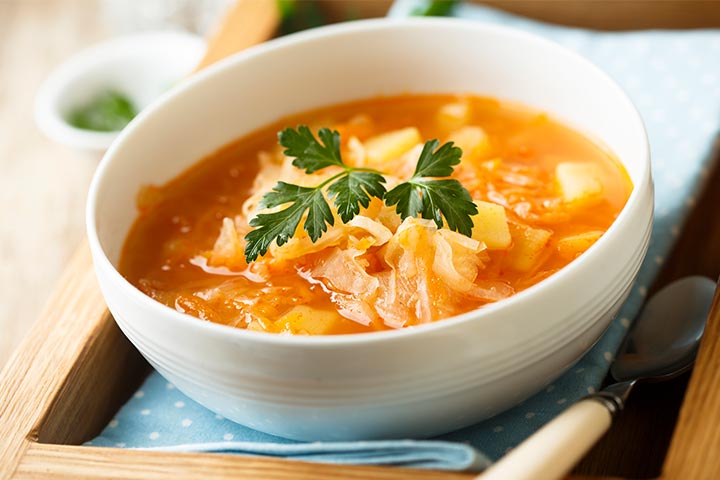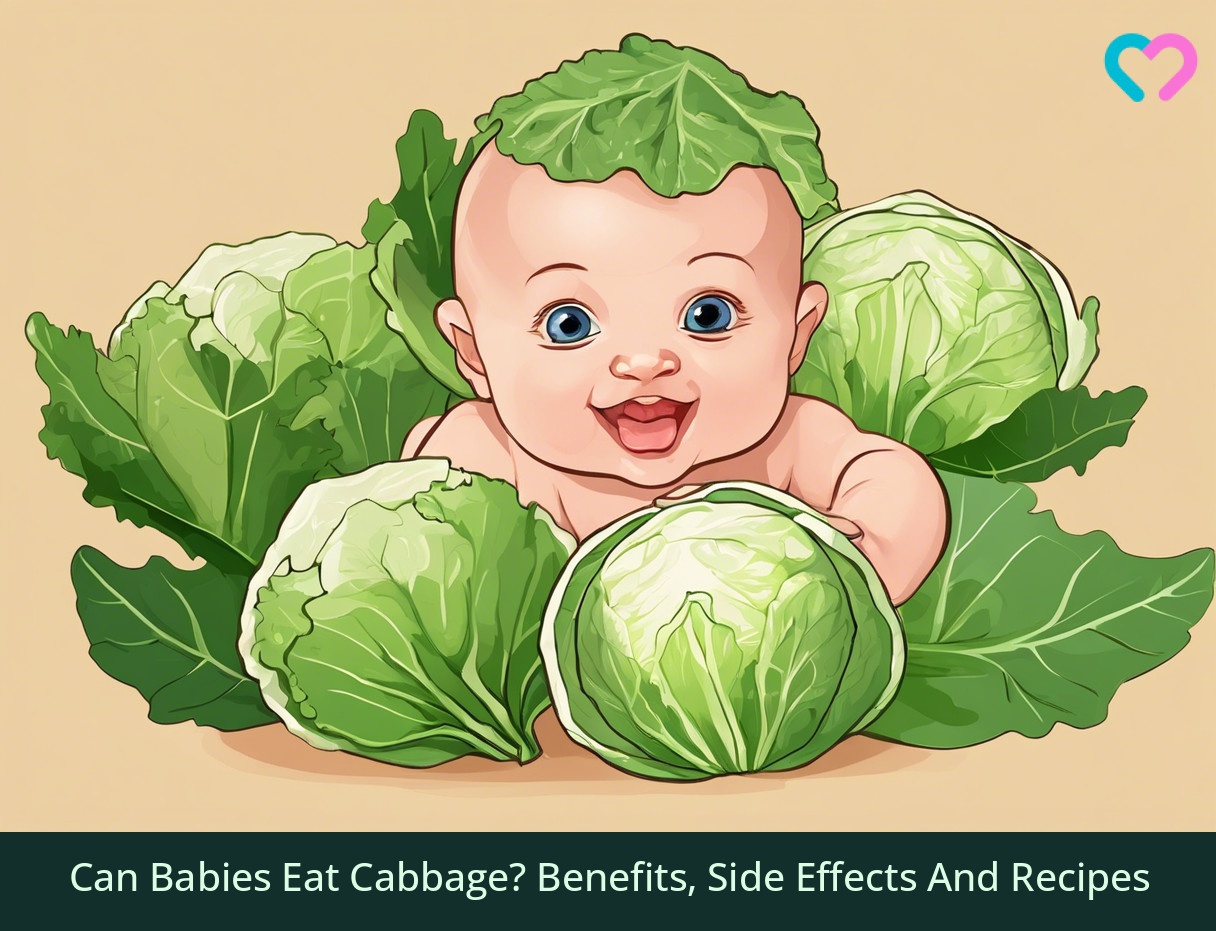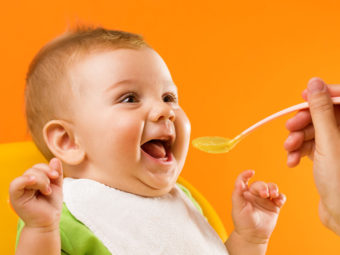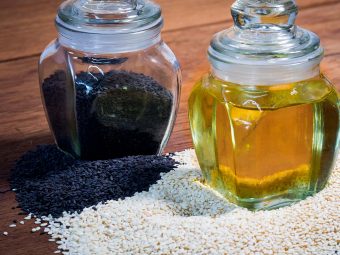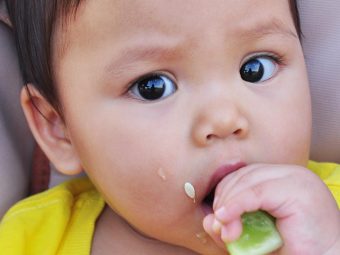
Image: Shutterstock
You may introduce cabbage for babies already eating solid foods such as rice porridge and vegetable purees. Cabbage, also called Brassica oleracea, is available in different varieties, such as with smooth or wrinkled leaves and green, red, white, and purple colors. This leafy vegetable is packed with micronutrients and bioactive compoundsiXChemicals found in some plants and certain foods, known to confer several health benefits . They are also rich in flavonoidsiXA group of naturally-occurring antioxidant and anti-inflammatory compounds found in plants and fruits such as apigenin, kaempferol, and quercetin (1).
Fibers in cabbage also help to prevent constipation. You may use the leafy part rather than the middle part that connects the leaves on the sides to avoid issues such as gas formation. Read on to understand the health benefits, side effects, and when is the right age to feed cabbage to babies. We also share some exciting cabbage recipes for babies.
Can Babies Eat Cabbage?
Yes, babies can eat cooked cabbage. The vegetable can be introduced to babies in the form of puree. Then, as your baby grows, you can add cabbage to their regular meal in different forms such as soup, curry, salad, and dessert. This vegetable is tasty, healthy, inexpensive, and versatile so it deserves some more space in your babies food menu.
When Can Babies Have Cabbage?
Your baby can start having cabbage from the age of six months. Weaning babies who have started solids such as rice and potato can generally be introduced to cabbage. However, not all babies are ready for solids at the same time. Therefore, consult a pediatrician or pediatric nutritionist before introducing cabbage to your baby. Once satisfied, this vegetable would be a great addition to your babies diet as it has so many potential health benefits.
Nutritional Value Of Cabbage
Cabbage is a nutritionally balanced vegetable and a commonly consumed low-calorie food. The nutritional value can vary as per the type of cabbage. The common varieties are greens, spring greens, white, savoy, bok choy, napa cabbage, and red cabbage. Almost all these varieties can be given to babies. However, green cabbage is the most commonly consumed type in the world.
Half a cup of cooked green cabbage contains the following nutrients corresponding to the daily requirement of these nutrients for babies (RDA) (2) (3).
| Name | Amount | RDA |
|---|---|---|
| Water | 69.4g | – |
| Energy | 17.2kcal | – |
| Carbohydrate, by difference | 4.13g | – |
| Fiber, total dietary | 1.42g | – |
| Calcium, Ca | 36mg | 210mg (0-6 months) 270mg (7-12 months) |
| Magnesium, Mg | 11.2mg | 30mg (0-6 months) 75mg (7-12 months) |
| Phosphorus, P | 24.8mg | 100mg (0-6 months) 275mg (7-12 months) |
| Potassium, K | 147mg | 500mg (0-6 months) 700mg (7-12 months) |
| Sodium, Na | 6mg | 120mg (0-6 months) 200mg (7-12 months) |
| Vitamin C, total ascorbic acid | 28.1mg | 30mg (0-6 months) 35mg (7-12 months) |
| Folate, total | 22.5µg | 25µg (0-6 months) 35µg (7-12 months) |
| Choline, total | 15.2mg | – |
| Vitamin A, IU | 60IU | 1167 IU |
| Vitamin K (phylloquinone) | 81.5µg | 5 (0-6 months) 10 (7-12 months) |
It also contains Iron and riboflavin in small quantities
Sources: U.S. Department of Agriculture and World Health Organization
Health Benefits Of Cabbage For Babies
Cabbage has been used in traditional medicine to treat various diseases (4). The therapeutic properties of cabbage are attributed to its diverse nutritional profile. Some of the impressive health benefits of cabbage that your baby could reap by regular consumption of cabbage in moderation are:
- Digestive health: Cabbage is a good source of dietary fiber, It is full of gut-friendly insoluble fiber which adds bulk to stools and promotes regular bowel movements. It is rich in soluble fiber too, which has been shown to increase the number of beneficial friendly bacteria like Lactobacilli. The vegetable also contains compounds such as glucosinolatesiXPlant-based biologically active compounds with anti-oxidant and anti-inflammatory properties that certain bacteria in the body can hydrolyze and use as prebiotics (5). PrebioticsiXCompounds that improve overall health by acting as food for the good bacteria present in the human gut help boost gut microfloraiXA complex ecosystem of microorganisms residing in the intestine .
- Cardiovascular health: Some research studies have demonstrated that regular consumption of steamed vegetables of Brassica family, such as cabbage, can have cardioprotective effects (6). A study published in the American Journal of Clinical Nutrition showed a sulfur-containing compound glucosinolate is associated with the reduction of oxidative stressiXA condition of too many free radicals and a lack of antioxidants to remove them and inflammation. Glucosinolate is present in cabbage (7). Red cabbage contains powerful compound anthocyaninsiXDeep red, blue, and purple pigments found in plants , which gives it vibrant color making it an excellent choice for heart health. Substances called phytosterolsiXBioactive compounds found in plant products that may help lower cholesterol levels help in reducing LDL cholesterol.
- Enhanced immunity: A research report published in the Journal of Oxidative Medicine and Cellular Longevity showed that red cabbage possesses immunomodulatory properties due to the presence of anthocyanins (8). Cabbage also has antioxidant and anti-inflammatory properties due to the presence of high levels of anthocyanins and flavonoids like kaempferol, sulforaphane, which boost immunity (9).
- Healing properties: Cabbage finds use in traditional medicine due to its antioxidant and anti-inflammatory effects. It is used to treat various ailments such as gastritisiXA mucosa or stomach lining infection characterized by swelling, pain, indigestion, and nausea , peptic ulcers, duodenal ulcersiXOpen sores or ulcers in the small intestine , and irritable bowel syndrome. It might also help in healing wounds and curing mastitisiXA painful infection of the breast tissue that causes inflammation, swelling, and redness . A study published in the Journal of Bioscience, Biotechnology, and Biochemistry showed that cabbage leaves have high levels of lysophosphatidic acid (LPA), which is required during the wound healing process (10).
- Presence of vitamins: It contains vitamin B6, which is essential for many important processes in the body, including energy metabolism and normal function of the nervous system. Vitamin K in cabbage acts as a cofactor in blood clotting. Being an excellent source of vitamin C, the vegetable helps in collagen building and gives flexibility to the skin. It is also critical for the proper functioning of the bones, muscles, and blood vessels. Vitamin A being a good source of beta carotene is good for eyes too.
Regular consumption of cabbage in moderate amounts can have overall health-promoting effects. However, you need to know about the possible side-effects too.
 Quick tip
Quick tipPossible Side-Effects Of Cabbage For Babies
Like any other food, cabbage, too, has some possible side-effects when consumed in large amounts. Some of them are:
- Flatulence: Cabbage is a cruciferous vegetable that is rich in sulfur and dietary fiber and can upset your baby’s stomach health. These substances often contribute to gas formation. Almost all the varieties of cabbage cause gas formation. Fiber is beneficial but only in small quantities; else it can cause diarrhea. Hence, their consumption by babies must be controlled well. If the baby has coliciXFrequent, prolonged, and intense periods of crying in a healthy baby without any apparent reason the excessive gas formation can cause discomfort that can worsen further, making colic relief necessary.
- Blue baby syndrome: Blue baby syndrome or methemoglobinemia occurs when hemoglobin is unable to carry oxygen to body tissues, thus making the skin and lips turn blue. Infants are more susceptible to it because of the immature digestive system. Vegetables that are naturally high in nitrate can lead to this condition. Ingestion of Chinese cabbage has been associated with methemoglobinemia. You can avoid this variety and consider alternative types of cabbage to feed your baby (11).
- Goitrogens: Certain foods, when consumed raw, can suppress the functioning of the thyroid gland by interfering in the uptake of iodine. It can be detrimental for your baby’s health as thyroid functioning is pivotal for proper mental and physical growth (12). Therefore, avoid serving raw cabbage to your baby. However the benefits may outweigh the potential side effects of goitrogens.
- Anti-thiamin: Certain vegetables such as cabbage are known to have thiaminase. Thiaminase is an enzyme that breaks vitamin B1 (thiamin) and renders it inactive. Vitamin B1 is a crucial vitamin for the healthy mental and physical development of babies. The good thing is that cooking can destroy thiaminase (12). Thus, the consumption of cabbage should be done in cooked form.
- Anti-mineral: Oxalic acid is an inorganic salt that binds with calcium and other minerals and renders them insoluble. When minerals become insoluble, their bioavailability reduces, thus leading to health implications. Cabbage contains oxalic acid, and cooking does not break it down. Therefore, babies should have cabbage in moderate amounts. Remember, moderate intake does not lead to such problems in healthy babies (12).
- Allergy: Cabbage allergy is rare but possible. If your baby is allergic to any food in the Brassica family, like broccoli and kale, then there are high chances the baby could be allergic to cabbage (13). In such a case, consult a pediatrician before feeding cabbage to your baby.
Regular, moderate intake of cabbage is usually safe and seldom a cause for concern.
Cabbage Recipes For Babies
When preparing homemade baby food, it is recommended that cabbage be cooked before serving to the baby. The digestion of raw cabbage can be challenging for a baby’s tummy. The baby can also be exposed to pathogens and harmful compounds present in raw cabbage. This versatile vegetable can be eaten steamed, fermented, or juiced. It is important to nourish your baby’s body regardless of how you choose to feed it. Below are some recipes that you might like to try.
1. Carrot and cabbage puree
Carrot and cabbage puree is the simplest recipe for babies who have just started solids. This recipe has a nutritional combination of cabbage with the carrot. You can serve it as a midday snack.
You will need:
- ½ cup cabbage (chopped)
- ½ cup carrot (chopped )
- A pinch of pepper
- 1tsp unsalted butter
- Salt (to taste)
How to:
- Cook the cabbage and carrot, and then add pepper and salt to it.
- Once done, add butter and blend.
- Cabbage and carrot puree is now ready to serve.
Tip: You can combine cabbage with other vegetables that your baby eats. Combining the cabbage with grains and protein sources, such as cheese, is also a good idea.
 Quick tip
Quick tip2. Cabbage and lentil soup
Soups are warm, soulful, easy to digest, and work as nutritionally sumptuous appetizers. Here is one such recipe that you may try for babies, who have started solids.
You will need:
- 4 cups fresh vegetable stock
- 1 cup onion (chopped)
- 1 28oz canned tomatoes (whole and peeled)
- ½ green cabbage (chopped)
- 2 cup green lentils (cooked)
- ½tbsp garlic (minced)
- 1tsp basil
- Ground pepper, to taste
- Salt, to taste
- Virgin olive oil
How to:
- Heat olive oil in a large pot over medium heat.
- Once the oil is warm, add onions and cook until they turn golden brown.
- Stir in garlic and basil. Cook for two more minutes or until they start giving a fine aroma.
- Now, add stock, tomatoes, and cabbage. Bring everything to a boil.
- Reduce heat and simmer for at least 25-30 minutes. Once the tomatoes look all mixed, and cabbage looks tender, add in cooked lentils. Simmer for more 20 minutes or until everything is cooked.
- Switch off the flame and keep the pot aside to cool. Blend everything till you get a soup with flowy consistency. Adjust the consistency by adding water.
- Serve the soup in a soup bowl. Add salt and pepper powder to taste. You can also use carrot instead of lentil, to make cabbage and carrot soup. Cabbage can have strong flavor, so it works best with other foods.
3. Cabbage rolls
Once your baby is seven to nine months old, you may introduce some mouth-watering finger foods as part of your baby-led weaning approach. One such recipe is cabbage rolls. You can add meat or chicken or tofu with a variety of vegetables as stuffing. However, before adding any ingredient to the stuffing, check for possible allergens.
You will need:
- ½ cup brown rice (cooked)
- 2 small green cabbage heads
- 1 carrot (grated)
- 2 capsicums (grated)
- 1 cup cottage cheese (mashed)
- 1 large onion (chopped)
- 1 cup fresh parsley (chopped)
- Salt, to taste
- Ground pepper, to taste
- Sesame oil
How to:
To make the filling:
- Take a flat bottom pan and put it over the stove on medium heat.
- As the pan gets warm, add two to three tablespoon oil and add onions. Cook the onions over low heat until they turn translucent brown. Once done, keep the pan aside.
- Now, take a large bowl and add cottage cheese, carrots, rice, capsicum, salt, and pepper. Mix everything well and keep the bowl aside.
- 4. Cut the bottom of the cabbage and remove the leaves away from the stalk.
- Preheat the oven to 180°C (356°F) and start preparing the rolls.
To make rolls:
- Take a cabbage leaf and put two tablespoons of filling at the bottom of the wide part of the leaf. Roll it like a burrito – tucking sides in. Make as many rolls as you want.
- Place all the ready rolls in a baking casserole and pour some homemade tomato sauce over it. Cover the lid of the casserole and bake the rolls for almost an hour.
- Once the rolls are done, take the lid off and bake the rolls for an additional 30 minutes.
- Serve the rolls with fresh homemade hummus or cream sauce.
Tip: Before you serve the rolls to the baby, it cut them into two halves for ease of eating.
4. Cabbage Zucchini Porridge
Carrot and zucchini porridge is another simple recipe for babies starting solids. It can be served as a meal or a snack.
You will need:
- 45g rice
- 30g zucchini (chopped)
- 30g cabbage (chopped)
- ]350ml water
- 180ml sea tangle or kelp (organic seaweed)
How to:
- Soak rice in water
- Add the cabbage and zucchini to the soaked rice and steam for 25 minutes
- Transfer to a blender, add kelp stock and grind.
Frequently Asked Questions
1. Can I freeze cabbage for baby food?
Yes. It is usually recommended to blanch the cabbage before freezing it so that you can freeze it for longer. Blanched cabbages can be frozen for up to 18 months (16). Thoroughly clean all parts of the cabbage before blanching and freezing it. Remember not to refreeze thawed cabbage.
2. Can cabbage help with teething pain in babies?
Cabbage leaves are not a proven natural remedy for teething pain in babies. Although some parents may use them, no scientific evidence supports their effectiveness in relieving discomfort.
3. How long can I store cabbage baby food in the fridge?
Cooked cabbage baby food can be stored in the refrigerator for up to three days. You may freeze and store it in the freezer for up to eight months (17). Never refreeze or refrigerate thawed or cooled baby food since it may cause bacterial propagation.
Cabbage is a popular vegetable high in dietary fiber, vitamins, and bioactive substances, all of which contribute to the baby’s healthy growth and development. It’s simple to incorporate spinach into your baby’s diet as cabbage puree and soup if they are six months or older and have started consuming solid foods. However, too much cabbage intake might cause flatulence, blue baby syndrome, allergies, and other adverse effects. Thus, make sure your baby’s diet does not contain too much of cabbage.
Infographic: What Are The Side Effects Of Giving Excessive Cabbage To Babies?
It is generally not recommended to give large amounts of cabbage to babies. Cabbage, like other cruciferous vegetables, can cause gas and bloating. If you are unsure about how much cabbage to give your baby, it is best to consult your pediatrician. The following infographic provides more information about the potential side effects of feeding too much cabbage to your little one. Illustration: Momjunction Design Team
Key Pointers
- Flavonoids and essential nutrients are abundant in cabbage.
- Babies can consume cabbage once they start consuming solid foods, typically around six months of age.
- The fiber present in cabbage can help in preventing constipation and can be pureed or added to various dishes.
- Cabbage is known for its therapeutic benefits, especially for digestive, cardiovascular, and immune health, as per traditional medicine.
Image: Stable Diffusion/MomJunction Design Team
References
1. Chun OK et al.; Antioxidant properties of raw and processed cabbages..; National Center For Biotechnology Information
2. Cabbage, cooked, boiled, drained, without salt, (; Food Data Central; USDA
3. Feeding and nutrition of infants and young children; WHO
4. Dong Kwon Yang; Cabbage (Brassica oleracea var. capitata) Protects against H2O2-Induced Oxidative Stress by Preventing Mitochondrial Dysfunction in H9c2 Cardiomyoblasts; National Center For Biotechnology Information
5. Fei Li et al.; Human Gut Bacterial Communities Are Altered by Addition of Cruciferous Vegetables to a Controlled Fruit- and Vegetable-Free Diet; National Center For Biotechnology Information
6. Kahlon TS et al.; Steam cooking significantly improves in vitro bile acid binding of collard greens, kale, mustard greens, broccoli, green bell pepper, and cabbage..; National Center For Biotechnology Information
7. Xianglan Zhang et al.; Cruciferous vegetable consumption is associated with a reduced risk of total and cardiovascular disease mortality; National Center For Biotechnology Information
8. Ilaria Peluso et al.; Effects of High Consumption of Vegetables on Clinical, Immunological, and Antioxidant Markers in Subjects at Risk of Cardiovascular Diseases; National Center For Biotechnology Information
9. Youjung Lee et al.; Anti-inflammatory Effects of Brassica oleracea Var. capitata L. (Cabbage) Methanol Extract in Mice with Contact Dermatitis; National Center For Biotechnology Information
10. Tanaka T et al.; Formation of lysophosphatidic acid, a wound-healing lipid, during digestion of cabbage leaves.; National Center For Biotechnology Information
11. Nitrate and Nitrite in Vegetables and Infant Feeding; Center For Food Safety; The Government of the Hong Kong Special Administrative Region
12. Laurie C. Dolan et al.; Naturally Occurring Food Toxins; National Center For Biotechnology Information
13. Cabbage Allergy: A Rare Cause of Food-induced Anaphylaxis; ActaDV
14. Cabbage; NutritionFacts
15. Cabbage; VT Feed
16. Freezing Cabbage; Colorado State University Extension
17. Making safe baby food; University of Minnesota Extension





 Quick fact
Quick fact
